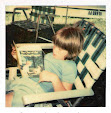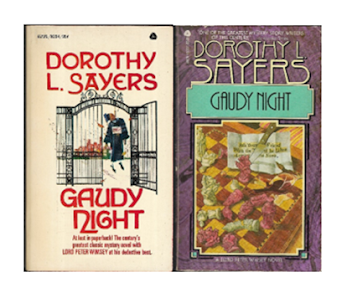Poison for Teacher (1949) by Nancy Spain
Miriam Birdseye (the Miriam Birdseye, former actress), has set herself up as a private investigator after a few episodes of mysterious adventures (Poison in the Play; Death Before Wicket; Murder--Bless It; and Death Goes on Skis). Business isn't particularly booming, but then her frequent partner in crime, Natasha DuVivien (ex-ballet dancer), leaves her husband and comes to live and work with her. She's barely arrived when the headmistress of Radcliff Hall School for Girls Miss Janet Lipscoomb arrives seeking detective services.
Someone is playing the most disagreeable tricks on the headmistress and the school. Flowerpots crash down near her when she's walking. Blackboards are wetted so they squeak horribly when written on. A hedgehog is put in her bath. The stairs are greased. Rude pictures drawn. And now, it's taken a more diabolical turn. Someone had frayed the gym ropes just before Miss Lipscoomb was to demonstrate "Flying Angels" to the fourth form girls. So, she wants Birdseye et Cie (Miriam's detective agency) to investigate.
After hearing about how there is bad blood between Miss Lipscoomb and her ex-partner, Miss bbirch, after the latter left and took the elocution and dancing instructors with her, Miriam is sure that Miss bbirch is behind it all. But they need to find proof. So, Miriam and Natasha go undercover as the new elocution and dancing instructors with the hopes of discovering the trickster. What they don't anticipate is that they will soon be looking for a murderer as well. The first victim of the murderer is Miss Theresa Devaloys, the French mistress. She had a nasty, sly sense of humor and her nose in everyone's business...and little notebook with what looks like a list of blackmail victims. She's poisoned during the rehearsal for the school play (in which her character drinks from a fresh bottle) and the finger of suspicion soon falls on Peter Bracewood-Smith, who provided the bottle and whose name figured prominently in the woman's little notebook, as well as on Dr. Lariat, who has access to poisons and who had an affair with her. An affair that he wanted ended and she didn't...Of course, when they discover that Devaloys was behind the nasty tricks at the school then suspicion falls on Miss Lipscoomb as well. How far would she go to protect her school? The police choose their favorite and our detectives choose theirs, but which way will the evidence point?
This works much better as a period piece and study of standard character types than it does as a mystery. The culprit is obvious even though Spain tries very hard to give us red herring alternates. I never seriously considered the other contenders--especially when Sergeant Tomkins latches so firmly onto one of them.What Spain does do well is provide the reader with a solid look at what the reading public of the 1940s considered standard character types (whether they would pass muster today or not) and then lampoons them--she sends them over-the-top and manages to make readers (this one, anyway) believe that she didn't agree with the stereotypes at all. She also creates an atmosphere where sexual attraction of all sorts are represented and no one (well, nearly no one--Johnny DuVivien is a tad uncomfortable at one point) bats an eye.
I hunted this down because it was an academic mystery and I do love those. I found it interesting because of the snapshot we get of the 1940s academic scene as well as the descriptions of the characters and the village where Radcliff Hall is located. But what I'm going to remember from the story is Natasha. She is a fervent little detective in the making and a delightful character all around. If anything makes me look for more Nancy Spain books, it will be Natasha. ★★★
First line: "Of all the stinking, boring, belly-aching tunes," shouted Johnny DuVivien passionately, "that one jest about takes anyone's cake!"
"A curious thing about champagne, madam," said Bracewood-Smith, "is that one can usually find someone who does not mind drinking it." (p. 44)
It is a curious fact that novelists, when presented with romantic facts in real life, usually refuse to believe them. (p. 74)
He was intelligent and hard-working, untroubled be high-brow considerations. He had four shaming pen-names to which he admitted...he even wrote love-stories, calling himself Mavis Clare, for the women's magazines. He wrote very fast and glibly straight on to the typewriter, in double spacing on quarto sheets. He sent his manuscripts straight to the publisher as he typed them. There were seldom errors in spelling, punctuation, or typing. P. Bracewood-Smith's errors were all errors of taste. He wrote excruciatingly badly. (p. 82)
[about borrowing books]
"Can I take two, please, Miss Fork-Thomas?" said Molly Ruminara. "I do read ever so fast. Although it is against your rules."
"If you like," said Gwylan vaguely, still looking out of the window. "which two do you want?"
"...May I take Strong Poison, by Sayers, and Death and the French Governess, by P. Bracewood-Smith?"
"Do," said Gwylan, even more vaguely. "The Bracewood-Smiths aren't in the same class as the Sayers, of course, though." (p. 120)
"But, Miriam, we are supposed to be detectives, darling. You too should be interested in the contents
of handbags. It is the very first thing." (Natasha; p. 142)
[about murders happening at the Radcliff Hall school] "Shouldn't let that put you off, dear, about Joan....I should think your daughter will love them. Children always love a good murder." (Henry, a waiter; p. 166)
Natasha's instinct always worked in this disorderly way, flinging up startling messages to her sensitive and receptive mind. I had now presented her with a gambler's certainty without a shadow of evidence or proof. (p. 189)
Natasha was suffering from a fever of conceit, based on her immediate past [involvement in previous mysteries]. She was sick of enforced confessions and spectacular and unresolved endings. She wanted no more murderers committing suicide or leapong screaming into Broadmoor. Nothing short of the Old Bailey and a darling judge in a black cap would satisfy her. (p. 191)
Last line: The violent, unmistakable rash of scarlet fever had risen there, and was still rising.
*********************
Deaths = 4 (one fell from height; one natural; one poisoned; one shot)









.jpg)










.jpg)



.jpg)
.jpg)




















































